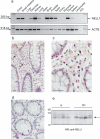Systematic association mapping identifies NELL1 as a novel IBD disease gene
- PMID: 17684544
- PMCID: PMC1933598
- DOI: 10.1371/journal.pone.0000691
Systematic association mapping identifies NELL1 as a novel IBD disease gene
Abstract
Crohn disease (CD), a sub-entity of inflammatory bowel disease (IBD), is a complex polygenic disorder. Although recent studies have successfully identified CD-associated genetic variants, these susceptibility loci explain only a fraction of the heritability of the disease. Here, we report on a multi-stage genome-wide scan of 393 German CD cases and 399 controls. Among the 116,161 single-nucleotide polymorphisms tested, an association with the known CD susceptibility gene NOD2, the 5q31 haplotype, and the recently reported CD locus at 5p13.1 was confirmed. In addition, SNP rs1793004 in the gene encoding nel-like 1 precursor (NELL1, chromosome 11p15.1) showed a consistent disease-association in independent German population- and family-based samples (942 cases, 1082 controls, 375 trios). Subsequent fine mapping and replication in an independent sample of 454 French/Canadian CD trios supported the authenticity of the NELL1 association. Further confirmation in a large German ulcerative colitis (UC) sample indicated that NELL1 is a ubiquitous IBD susceptibility locus (combined p<10(-6); OR = 1.66, 95% CI: 1.30-2.11). The novel 5p13.1 locus was also replicated in the French/Canadian sample and in an independent UK CD patient panel (453 cases, 521 controls, combined p<10(-6) for SNP rs1992660). Several associations were replicated in at least one independent sample, point to an involvement of ITGB6 (upstream), GRM8 (downstream), OR5V1 (downstream), PPP3R2 (downstream), NM_152575 (upstream) and HNF4G (intron).
Conflict of interest statement
Figures




References
-
- Loftus EV., Jr Clinical epidemiology of inflammatory bowel disease: Incidence, prevalence, and environmental influences. Gastroenterology. 2004;126:1504–1517. - PubMed
-
- Schreiber S, Rosenstiel P, Albrecht M, Hampe J, Krawczak M. Genetics of Crohn disease, an archetypal inflammatory barrier disease. Nat Rev Genet. 2005;6:376–388. - PubMed
-
- Orholm M, Munkholm P, Langholz E, Nielsen OH, Sorensen TI, et al. Familial occurrence of inflammatory bowel disease. N Engl J Med. 1991;324:84–88. - PubMed
-
- Kuster W, Pascoe L, Purrmann J, Funk S, Majewski F. The genetics of Crohn disease: complex segregation analysis of a family study with 265 patients with Crohn disease and 5,387 relatives. Am J Med Genet. 1989;32:105–108. - PubMed
Publication types
MeSH terms
Substances
Grants and funding
LinkOut - more resources
Full Text Sources
Other Literature Sources
Molecular Biology Databases

